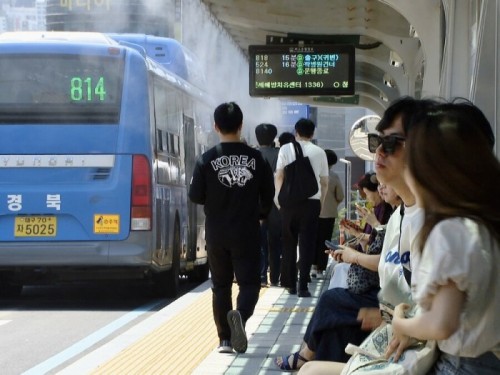 |
| A cooling fog is in operation at the bus stop in front of Dongdaegu Station in Daegu on June 12, 2024, when a heatwave warning was issued. / Source: Yonhap News |
AsiaToday reporter Jeong Min-hoon
The highest daytime temperature in inland areas such as Daegu exceeded 35 degrees Celsius on Thursday, raising concerns about the worst heat wave ever this summer. With the scorching heat starting earlier than usual, an emergency light has been turned on in the daily lives of the people, including vulnerable groups who find it hard to have a proper fan.
The Korea Meteorological Administration (KMA) predicted on Thursday that the heat wave would start about a week earlier than last year and that the temperature this summer would be higher than usual. The KMA’s three-month prediction shows that there is a 40 to 50 percent chance that temperatures in June and August will be higher than the average posted in the past 30 years, due to the strengthening of the high-pressure cycle near Korea.
An analysis of 503 climate prediction model data provided by meteorological agencies and related institutions from 12 countries around the world also indicated that there is a 74 to 80 percent chance that temperatures in June and August will be higher than usual, raising concerns that the nation could see the extraordinary hot 1994 and 2018 again.
The summer of 2018 had the greatest number of heat wave days issued at 31.4, followed by 29.4 in 1994.
Even in mid-June, temperatures exceeding 30 degrees led to heatwave warnings and tropical nights occurring more than a week earlier than last year. The cause of this heatwave is identified as the “warmed-up sea.” The sea surface temperature in the tropical western Pacific Ocean in the south of Korea and the tropical Indian Ocean in the southwest of Korea has remained higher than usual since spring, and the rising sea surface temperature in the region has created an upward airflow, strengthening the high-pressure cycle in East Asia.
Due to the influence of high pressure, the increase in solar radiation on the Korean Peninsula resulted in record-breaking heatwaves occurring.
Due to the early heat wave, heat-related illnesses are occurring across the country. According to the report by the Korea Centers for Disease Control and Prevention, a total of 108 cases of heat-related illnesses were reported from May 20 to June 11, with one suspected heat-related death. This is an increase of 42 percent compared to the same period last year.
As a protective measure for the vulnerable to the worst heatwave forecast, the government is providing cooling shelters, providing financial support for cooling costs, and more in case of a heat wave warning.
“The temperature in Korea from June to August is likely to be higher than usual due to the effect of thermal insulation,” a KMA official stated. “It is best to refrain from intense outdoor activities during this period.”
#KMA #summer #heat wave
Copyright by Asiatoday
Most Read
-
1
-
2
-
3
-
4
-
5
-
6
-
7





















